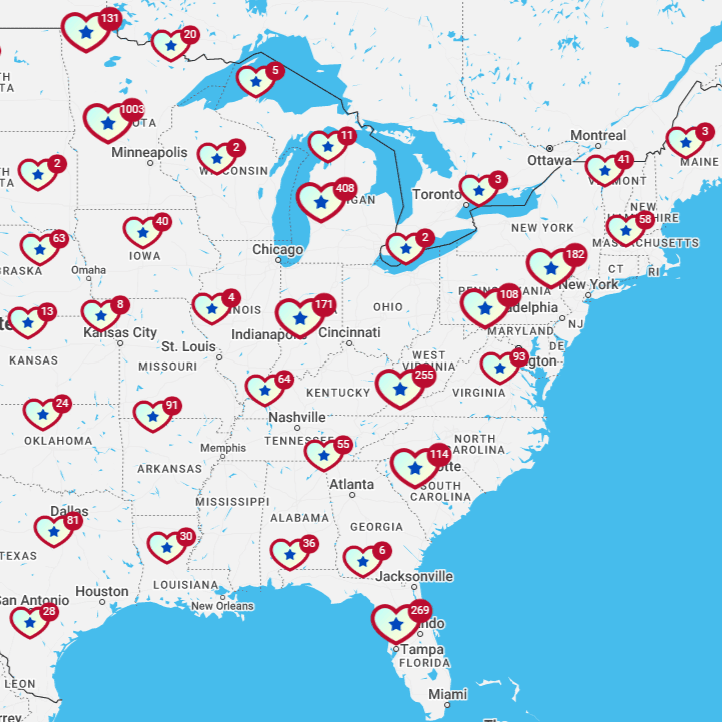
Navigating the Landscape of Partisan Politics
The modern political climate is ostensibly more partisan than ever. These days, Republicans and Democrats seem to disagree on virtually everything for the sake of disagreement.
There exists a widespread consensus among voters that political polarization is steadily increasing in the U.S. According to Pew Research, recent surveys show that 78 percent of the U.S. voting public perceives a drastic rise in ideological divisions between Republicans and Democrats. Only 6 percent believe these disparities are decreasing, leaving 16 percent who see them as stagnant.
Interestingly enough, substantial majorities within both political parties recognize this upward trend in partisanship. Though liberals hold a slightly lower percentage at 78 percent, conservatives express even greater concern, with 85 percent acknowledging an escalating intensity in a somewhat alarming partisan landscape.
Clearly, the above figures illustrate a shared worry about rising partisanship that transcends party lines and its impacts on political engagement. A striking 81 percent of adults surveyed by Pew Research express various degrees of worry over the growing differences between U.S. liberals and conservatives. In fact, nearly half of those surveyed admit to being "very concerned" about this ever-widening gulf and its potential impacts on healthy political engagement.
While comparable segments of liberals and conservatives alike urge caution over these troublesome partisan dynamics, (83 percent and 88 percent, respectively), left-of-center voters tend to be slightly more alarmed than their Republican counterparts.
Moreover, this pattern remains consistent among independents who lean toward either party. Around three-quarters of political independents who err toward either liberal or conservative ideologies acknowledge the intensifying divisions in U.S. politics. Likewise, these same voting demographics express similar levels of concern regarding the expanding partisan gap.
Whether due to a lack of bipartisan media discourse or traditionally low political participation numbers, voters from all backgrounds have become increasingly aware of the growing ideological divides. Pew's findings should serve as a poignant reminder of the urgency of bridging this widening gap and instigating more mass cultural unity amidst an intense era of political disparity.
What Is Partisan Politics?
In U.S. politics, the issues that separate Republicans and Democrats differ considerably. The partisan coalitions are shaped by several factors, with age gaps playing a more prominent role among Republicans.
Their opinions on foreign policy, immigration, and identity politics vary widely based on generational distinctions and, to some degree, voter education. In fact, educational attainment levels within both political parties form the point of departure for an even more prominent political divide.
The key to understanding partisan politics is seeing how these ideological divergences manifest themselves within both of the primary parties. Far-right-leaning conservatives are 30 percentage points less likely than their moderate and centrist Republican counterparts to support the idea that legalizing same-sex marriage has been advantageous for society.
Similarly, significant contrasts are evident among liberals based on ideological variances. Far-left-leaning liberals (roughly half of all Democrats, by Pew's estimate) differ notably from their party's moderates regarding religion, identity politics, and foreign policy.
Despite these inter-party disagreements, the disparities between U.S. conservatives and liberals remain more pronounced than those within the two primary political parties themselves. Across 30 political values encompassing areas like First and Second Amendment rights, race, immigration, and foreign policy, the average partisan gap stands at 39 percentage points.
Some political disparities are, of course, wider than others. For instance, concerning attitudes toward gun availability (not specific policies), the average difference in political ideology reaches 57 percentage points between the two dominant parties. While 86 percent of liberals and Democratic-leaning independents advocate for stricter gun laws, only 31 percent of conservatives and their elected leaders share this perspective, according to Pew Research studies.
Although the scale of the partisan divide on political dispositions has remained relatively consistent, a noteworthy shift has been visible since 1994. Over this period, the growing ideological gap between parties on these measures has more than doubled, while other disparities have seen little change in size.
A Brief History of Partisan Politics
The genesis of the two ideological factions in the United States and their political strategies is traceable all the way back to the intense debate surrounding the ratification of the federal Constitution in 1787. As the focus shifted from establishing a new federal government to determining its level of authority, ideological friction escalated significantly, becoming more prominent by the mid-1790s.
Two dominant political groups emerged at the time, each with distinct visions for the nation's future, spawning a marked increase in mass-cultural political awareness. The Federalists, led by Secretary of Treasury Alexander Hamilton, advocated for a strong centralized government with sweeping expansive powers. The Anti-Federalists, in contrast, spearheaded by Secretary of State Thomas Jefferson, championed the importance of states' rights over federal authority.
The rift between these factions extended beyond their differing ideologies and encompassed considerable support from distinct segments of U.S. society. The Federalists found their stronghold within the commercial sector, where individuals viewed a strong centralized government as crucial for promoting economic growth and stability.
Conversely, the Anti-Federalists drew their strength from an informed voting public favoring an agrarian society, who believed that too much power residing in a central authority would undermine individual liberties and local autonomy.
These clashing perspectives ignited fierce partisan battles and increasingly shrewd political engagement strategies that caught the attention of President George Washington, who eventually took an overwhelming victory in the first national election, an event that ostensibly transcended partisan ideology.
Disturbed by the divisive nature of party politics, Washington warned in his Farewell Address to the American people about the detrimental impact of "the baneful effects of the spirit of party." The country's first President had the foresight to understand how excessive attachment to party identity could hinder the collective welfare and unity of the then-budding nation.
Partisanship and Its Impact on Policy-Making and Governance
Party polarization often comes with negative stereotypes, but has long had a profound impact on United States governance. The undeniable truth is that the two major parties have experienced a growing divergence over time.
While some evidence points to substantive differences in policy preferences between liberals and conservatives, determining the extent of ideological polarization in a spatial sense is still no easy task. As partisanship took hold, it resulted in an increasingly hardened divide among party lines and a trend toward centralization of power within U.S. governmental bodies.
The rise of more cohesive parties has not necessarily translated into greater effectiveness when it comes to enacting policies or managing routine governing responsibilities. Instead, a phenomenon referred to as political "drift" seems to characterize the consequences of partisanship in executing public policy.
This phenomenon can be construed as a constant pendulum swinging back and forth between competing political ideologies to form a sort of stasis. Such a pattern, however, raises questions about the true impact of party polarization in terms of promoting extreme policy outcomes that favor liberalism or conservatism on purely semantic or polemical grounds.
Party polarization continues to shape governance in the United States. As such, an ongoing analysis in political science is required to fully grasp its implications for policy-making to address public needs and ensure a stable political milieu. The intricate interplay between partisan divisions and policy outcomes requires further exploration to navigate and understand the complexities of a polarized political environment.
Assessing the Partisan Landscape: Strategies for Voters
One of the key benefits of assuming multiple perspectives is its potential to encourage more empathy and broaden our understanding of different viewpoints. Some studies show that support for multicultural issues, for example, increased after participants were encouraged to partake in perspective-taking exercises that led to a clear shift in partisan attitudes. Even a brief exchange can encourage individuals to see the world through the eyes of "the Other," as it were, resulting in significant perspectival changes.
In light of modern communication technology, including the rise of social media, many political scientists express concerns about its impact on promoting understanding instead of driving more division through ad hominem attacks on political opponents. Social media platforms and governing bodies would do better to reflect on whether these technologies actually solve political communications problems or merely create new ones.
Do the prominent media platforms simply encourage a political landscape that emphasizes "side-taking" rather than empowering perspective-taking? What about information sourcing and fact-checking? As discussions evolve on how best to manage these platforms, bridging the gap between sides through empathy and voter education should be emphasized to establish a productive discourse that leads to more meaningful social progress.
Real-World Examples of Partisan Politics
In contemporary politics, both the left and the right are subject to "ideological siloing." This term refers to voters who harbor unwavering political positions and are more likely to associate with others who share their own views.
This trend has led to liberals, conservatives, and even independents disagreeing not only on politics but also on other aspects of life — for instance, where they want to live, the type of people they want to be around, and even whom they would accept into their families.
The polarization is so intense that many people believe that political negotiations should result in their side getting precisely what it wants, contributing to the ever-present gridlock on Capitol Hill. However, despite these divisions, the majority of the U.S. voting public does not hold such extreme ideological views, nor do they see either party as a threat to the nation. Indeed, most U.S. citizens believe that their representatives should strive for compromise rather than holding out for personal gain in the "political win," so to speak.
The impact of this ideological uniformity is particularly evident among politically engaged individuals. With regard to highly active Democrats, nearly four in ten (38 percent) identify as consistent liberals, a significant increase from only 8 percent in 1994.
On the Republican side, the change appears less dramatic, according to Pew studies, with 33 percent expressing consistently conservative views compared to 23 percent during the so-called 1994 "Republican Revolution." However, just a decade ago, only 10 percent of politically engaged voters on the right held across-the-board conservative attitudes.
So, in short, while those in the center remain relatively distanced and disengaged from political partisanship, the most ideologically oriented and politically rancorous constituencies and elected officials have a louder voice and more dominant influence at every stage of the political process. This resultant shift in dynamics displays an increasingly polarized political landscape where compromise seems fleeting and extremist agendas prevail.
The Consensus on Partisanship in Contemporary Politics
Modern political science tells us that, indeed, partisanship in contemporary political strategy has become more pronounced. Of course, this has led to an increase in ideological silos and more polarization among U.S. voters.
While some degree of political polarization is a necessary function of democracy, voters should still approach it within reason, maintaining an open mind throughout the democratic process. The current trend of extreme ideological views within the two primary factions and the refusal to compromise is ultimately detrimental to national progress and unity.
When voters engage an ideological perspective that prioritizes civil discourse and collaboration across the entire political landscape, they should find it easier to establish common ground and transcend partisan politics. This ability to see eye-to-eye on shared values and concerns promotes healthier democratic debate in which the public can more readily set aside its partisan differences out of respect for the common good.
To promote a more cooperative and inclusive political environment, consider joining the GoodParty.org community. GoodParty.org seeks to create a space where individuals from diverse political backgrounds can come together to engage in constructive dialogue, bridge ideological divides, and advocate for solutions that benefit the entire U.S. electorate.
